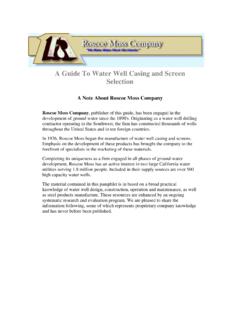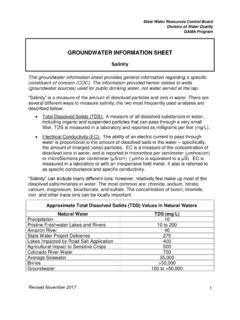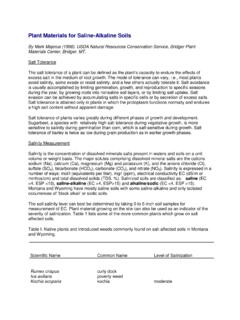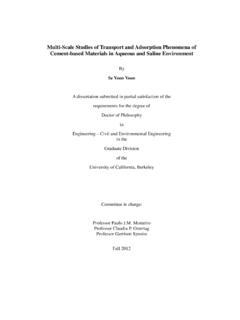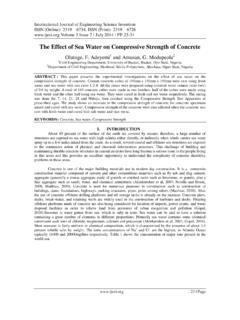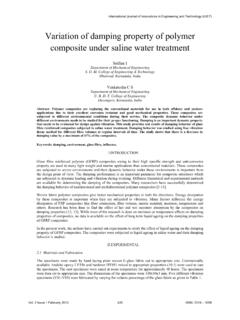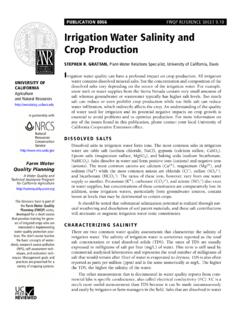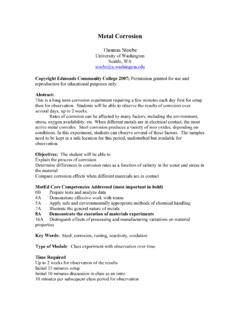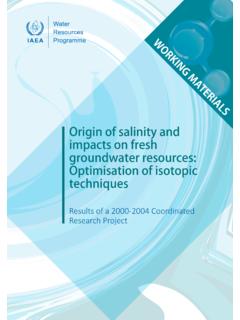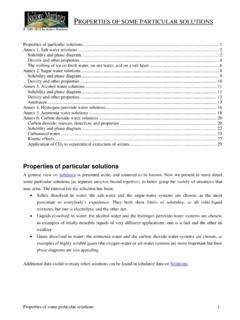Transcription of Fundamentals of Metallic Corrosion in Fresh Water
1 Fundamentals of Metallic Corrosion in Fresh Water By Rossum In preparation for this paper, I've examined some of the available literature on Water well Corrosion . I find that much of the material is either wrong, terribly confusing, or else completely misses the point. For example: "When Water contains less iron than the maximum that it is capable of carrying in solution, it corrodes iron or steel rapidly - unless a protective film or crust of some material covers the metal surface. The unsaturated Water tends to dissolve metal from the surface of well screens, well casing or piping systems until it becomes saturated with respect to iron.
2 If the mineral content of the Water is such that a protective film is not formed by deposition of insoluble materials, severe Corrosion results." [1] This concept is true only if we are talking about Metallic iron rather than ionized iron. However, the solubility of Metallic iron in Water is not reported in the literature, and is probably too small to measure. Serious Corrosion of steel casing from the solution of Metallic iron would take centuries or millenia. Corrosion experiments have not produced entirely satisfactory results. When a commercially useful metal is immersed in Water , we know it's going to corrode.
3 The question is, how fast? Since the useful life of most Water facilities is often several decades, some Corrosion experiments take too long to be practical. If the rate of Corrosion is accelerated, the very thing we want to know has been distorted. While Corrosion rates can be studied experimentally, in general these rates change with time. Corrosion in Fresh Water very often results in pitting so that, because of statistical variation in pit geometry, experiments under identical conditions will not yield identical results. The result of changes in experimental conditions may appear to be contradictory.
4 For example, normally an increase in temperature will increase the Corrosion rate, but it is possible for an increase in temperature to increase the Lagelier Index to a point where the Corrosion rate is greatly reduced. Because of these inherent difficulties, the results of experiments have failed to yield enough information to enable Corrosion engineers to calculate the useful life of pipe or other Metallic facilities exposed to Water . Nor is chemical thermodynamics particularly useful, since this subject deals largely with equilibrium conditions.
5 The information presented herein is based upon observation of corroding structures and the application of elementary chemical theory. In conversations, I have found that well drillers often use the term " Corrosion " to mean any process that causes incrustation. I will use the term to express a chemical attack on the metal. Since Corrosion products sometimes adhere to the Metallic surface, and are more voluminous than the corroded metal, Corrosion often causes incrustation. However, there are many instances where incrustation occurs without Corrosion .
6 Corrosion in Fresh or salt Water is always the result of an electrochemical reaction. To one who is not a chemist, the ten-n "electrochemical reaction" seems to denote a complicated phenomenon. As used to describe the Corrosion of metals, the application of electrochemical theory allows one to separate the relatively complicated Corrosion reaction into two simple parts: the anode reaction where the metal is oxidized, and the cathode reaction where the oxidizer is reduced. Neither of these reactions will occur without the other. Writing them as separate reactions is done only to describe how the overall Corrosion reaction takes place.
7 I hope that, by describing the chemical reactions that occur in a galvanic cell, I can make this clear. A galvanic cell results when two dissimilar metals are placed in an electrolyte. An electrolyte is a solution that contains ions (atoms or small groups of atoms that carry an electric charge) so that it will conduct electricity. Pure Water is a weak electrolyte and is a fair insulator or very poor conductor of electricity. It contains approximately 1/10,000,000 of a gram of hydrogen ions (H+) per liter and 17/10,000,000 of a gram of hydroxyl ions (OH-) per liter.
8 Since a hydroxyl ion weighs 17 times as much as a hydrogen ion, the two are chemically equivalent and there is no net charge. Sea Water is a strong electrolyte that contains almost 4% common salt that ionizes into sodium ions (Na+) and chloride ions (Cl-). Figure 1 shows a galvanic cell, consisting of two metal plates, one of which is steel and the other copper. As soon as the switch on this galvanic cell is closed, iron starts to corrode. Feo = F++ + 2e- Neutral iron atoms become ferrous ions with the liberation of two electrons. These two electrons pass through the ammeter to the copper electrode where they react with dissolved oxygen in the Water to form hydroxide ions: 4e- + 02 + 2H2O = 40H- Electric current flow through an electrolyte is by ionic migration.
9 Positively charged ions (Na+, Ca++ , etc.) flow to the cathode (more noble metal) while the negative ions (Cl-, SO4-, etc.) flow to the anode. Electron flow through Water cannot occur. Since electrons are involved, these corrosive reactions must occur at the metal-electrolyte interface. When the switch shown in Figure 1 is closed, a short-circuited galvanic cell is created (assuming negligible resistance in the external circuit). Thus the entire voltage drop occurs inside the cell. It can be shown with suitable equipment that most of this voltage drop occurs at the surface of the copper cathode.
10 The current flow is greatest initially. It decreases rapidly at first, more slowly later on. This decrease is caused by I 'polarization". Part of polarization results from depletion of the oxygen molecules in the electrolyte immediately adjacent to the cathode surface. The rest of it is caused by some phenomenon for which there is no completely satisfactory explanation. Some authorities attribute this phenomenon to the formation of various films. I think the easiest way to understand polarization is to look at each cathode material as a catalyst for the reduction of oxygen.
